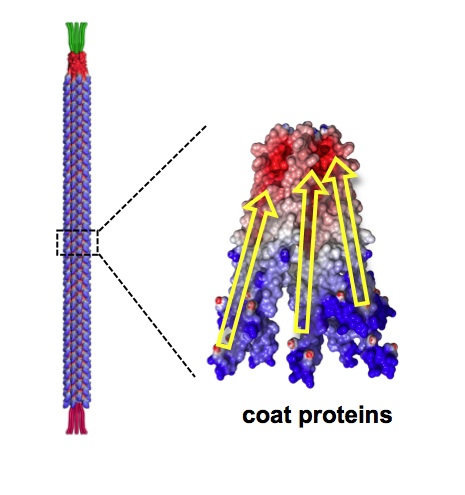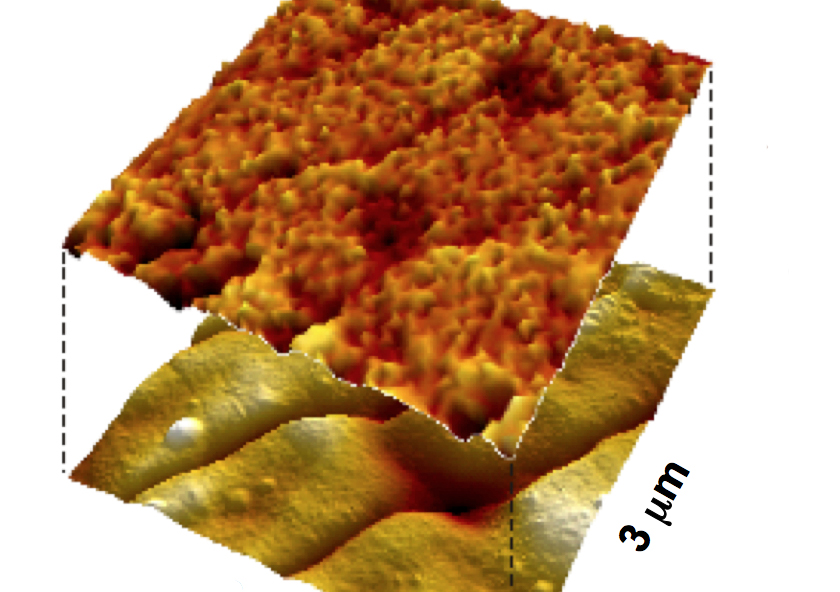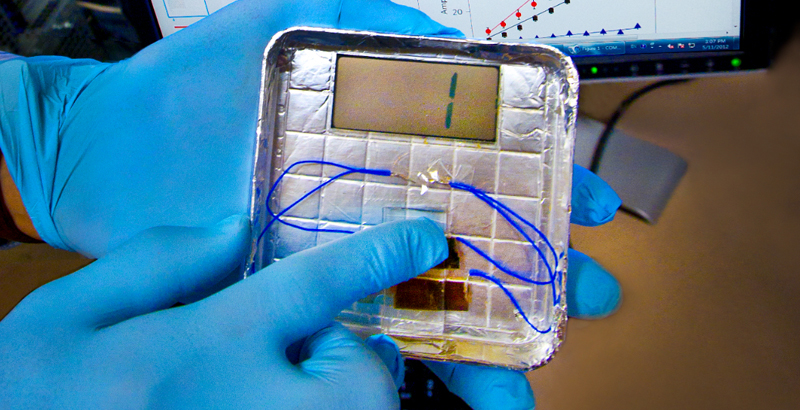Generating electricity from viruses as you walk
May 15, 2012
Scientists from the U.S. Department of Energy’s Lawrence Berkeley National Laboratory (Berkeley Lab) have developed a way to generate power using harmless viruses that convert mechanical energy into electricity.
The generator produces enough current to operate a small liquid-crystal display. It works by tapping a finger on a postage stamp-sized electrode coated with specially engineered viruses. The viruses convert the force of the tap into an electric charge.
Their generator is the first to produce electricity by harnessing the piezoelectric properties of a biological material. Piezoelectricity is the accumulation of a charge in a solid in response to mechanical stress.
The milestone could lead to tiny devices that harvest electrical energy from the vibrations of everyday tasks such as walking or shutting a door.

The M13 bacteriophage has a length of 880 nanometers and a diameter of 6.6 nanometers. It’s coated with approximately 2700 charged proteins that enable scientists to use the virus as a piezoelectric nanofiber. (Credit: Berkeley Lab)
It also points to a simpler way to make microelectronic devices. Using self-assembly, the viruses arrange themselves into an orderly film that enables the generator to work.
“More research is needed, but our work is a promising first step toward the development of personal power generators, actuators for use in nano-devices, and other devices based on viral electronics,” says Seung-Wuk Lee, a faculty scientist in Berkeley Lab’s Physical Biosciences Division and a UC Berkeley associate professor of bioengineering.
The materials used to make piezoelectric devices are toxic and very difficult to work with, which limits the widespread use of the technology.
Lee and colleagues used the M13 bacteriophage, which only attacks bacteria and is benign to people, would work. Being a virus, it replicates itself by the millions within hours, so there’s always a steady supply and it’s easy to genetically engineer.
And large numbers of the rod-shaped viruses naturally orient themselves into well-ordered films, much the way that chopsticks align themselves in a box.
To increase the virus’s piezoelectric strength, they used genetic engineering to add four negatively charged amino acid residues to one end of the helical proteins that coat the virus.

The top atomic force microscopy image maps the film’s structure-dependent piezoelectric properties, with higher voltages a lighter color. The bottom topographic image shows how the viruses align themselves side-by-side in a film. (Credit: Berkeley Lab)
These residues increase the charge difference between the proteins’ positive and negative ends, which boosts the voltage of the virus.
The scientists further enhanced the system by stacking films composed of single layers of the virus on top of each other. They found that a stack about 20 layers thick exhibited the strongest piezoelectric effect.
When pressure is applied to the generator, it produces up to six nanoamperes of current and 400 millivolts of potential. That’s enough current to flash the number “1” on the display, and about a quarter the voltage of an AAA battery.
“We’re now working on ways to improve on this proof-of-principle demonstration,” says Lee. “Because the tools of biotechnology enable large-scale production of genetically modified viruses, piezoelectric materials based on viruses could offer a simple route to novel microelectronics in the future.”
Ref.: Byung Yang Lee et al., Virus-based piezoelectric energy generation, Nature Nanotechnology, 2012, DOI: 10.1038/nnano.2012.69 (open access)
See also: New low-cost wearable energy source from piezoelectric nanocomposite
The first part of the video shows how Berkeley Lab scientists harness the piezoelectric properties of a virus to convert the force of a finger tap into electricity. The second part shows the “viral-electric” generators in action, first by pressing only one of the generators, then by pressing two at the same time, which produces more current.
